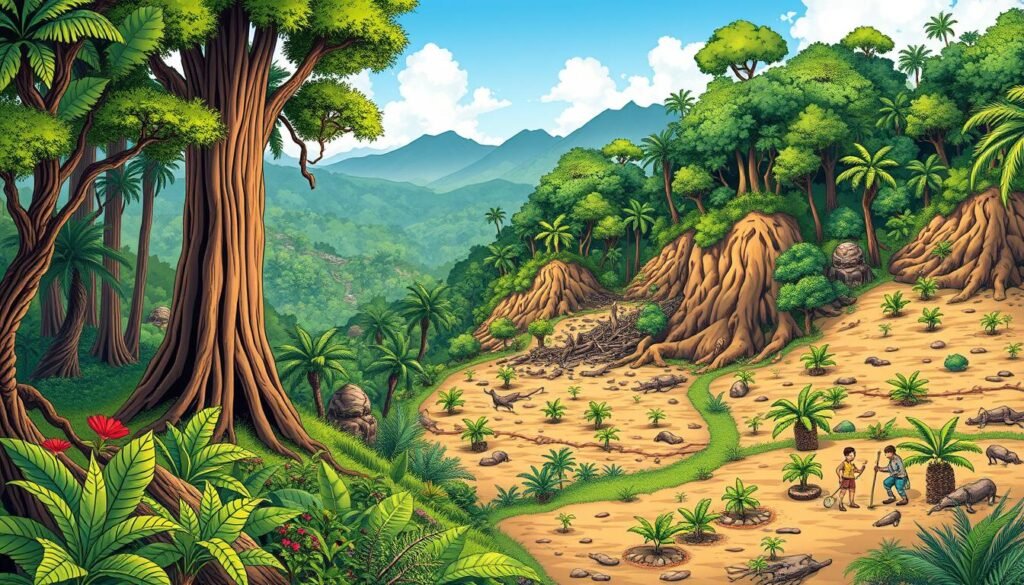What will happen to the environment if the Philippines loses all of its forests? The country is facing a significant threat from deforestation. Only about 24% of its land area remains forested as of 2019. This is a big drop from the 70% forest cover before the 16th century.
The rate of deforestation in the Philippines is very high. It loses about 123,000 hectares of forest cover every year. This is a major concern for the environment, and it’s essential to address it to prevent further damage.
Key Takeaways
- The Philippines has lost a significant amount of its forest cover over the years, with only 24% remaining as of 2019.
- The rate of deforestation in the Philippines is one of the highest in Southeast Asia, with 123,000 hectares of forest cover lost annually.
- Deforestation has a significant impact on the environment, including the loss of biodiversity and increased risk of flooding.
- The Philippine government has implemented policies to combat deforestation, including a logging ban and increased penalties for illegal logging.
- Non-governmental organizations are also working towards forest protection and restoration through programs like tree planting and biodiversity conservation.
- The success rate of reforestation projects is only about 30%, highlighting the need for more effective conservation efforts.
- Projections indicate that without reforestation efforts, the country could have no forest left by the year 2036, stressing the urgent need for action to protect the environment and prevent deforestation.
Overview of Deforestation in the Philippines
The Philippines has seen a lot of deforestation over the years. The country’s forest cover went from 70 percent to 20 percent in the 20th century. This big drop is mainly because of logging and other human actions that destroyed trees and their homes.
Some important numbers show how bad deforestation is in the Philippines:
- A total forest cover of 7.22 million hectares, which is 24.07% of the country’s land mass
- A loss of 1.42 million hectares of tree cover from 2001 to 2022, representing a 7.6% decrease
- Contribution to 848 metric tons of CO2 emissions from 2001 to 2022
It’s very important to tackle deforestation in the Philippines. It harms the environment and has big effects on the economy and society. Saving trees and their homes is key to keeping biodiversity and controlling the climate.
Historical Context of Forest Depletion
In the 16th century, the Philippines had 95 percent forest cover. By the early 20th century, this had dropped to 70 percent. This big drop is due to colonialism and modern challenges. Knowing why forests have shrunk is key to fixing deforestation today.
The environment has suffered from human actions, causing less forest. Conservation is vital to save what’s left and fix damaged areas. The Philippine government has started to fight deforestation with policies. Yet, more action is needed to keep forests safe for the future.

- Colonialism and the use of forest resources
- Modern issues like cities growing and more farms
- Not having good ways to protect and manage forests
Dealing with these issues is critical for a greener future in the Philippines. By learning from the past, we can help forests flourish again.
Environmental Consequences of Deforestation
Deforestation harms the environment in many ways. It leads to a loss of biodiversity, disrupts water cycles, and causes soil erosion and degradation. The Philippines, with its vast forests, is also affected. Logging activities have reduced forest cover, showing the need for conservation.
Every two seconds, a football pitch of forest is lost. Up to 15 billion trees are cut down each year. This hurts the environment, economy, and local communities.
Some major environmental impacts of deforestation are:
- Loss of biodiversity: Over 80% of animals, plants, and insects live in forests.
- Disruption of water cycles: Deforestation can reduce rain, affecting water availability and quality.
- Soil erosion and degradation: Without tree roots, soil erodes, leading to decreased fertility.
To lessen these impacts, we must use sustainable forest management. This includes reforestation, afforestation, and supporting conservation efforts. Together, we can reduce logging harm and ensure a better environment for the future.
| Environmental Consequence | Effect |
|---|---|
| Loss of Biodiversity | Extinction of species, disruption of ecosystems |
| Disruption of Water Cycles | Changes in precipitation, water availability, and quality |
| Soil Erosion and Degradation | Decreased soil fertility, increased erosion |
Economic Implications of Deforestation
Deforestation has big economic effects on local communities, the national economy, and the timber industry. It leads to the loss of trees, which are vital for a healthy environment. The FAO reports that about 10 million hectares of forest are lost each year globally from 2000 to 2020.
In the Philippines, forests are lost at a rate of around 250,000 hectares annually. This loss harms biodiversity and ecosystem services. The timber industry has been a big part of the Philippine economy but has caused a lot of deforestation. Saving forests could bring in about $2.5 trillion each year, showing the importance of managing forests sustainably.
Some major economic effects of deforestation include:
- Loss of ecosystem services, including the loss of trees
- Decreased biodiversity
- Reduced rainfall, leading to agricultural losses
- Increased greenhouse gas emissions

The cost of adapting to climate change is expected to rise to $140-$300 billion annually by 2030. By 2050, it could reach $280-$500 billion. Finding a balance between economic growth and environmental protection is key to reducing deforestation’s impact and promoting sustainability.
| Year | Global Forest Area (hectares) |
|---|---|
| 1990 | 4.1 billion |
| 2020 | 3.9 billion |
Deforestation and Climate Change
Deforestation is closely tied to climate change. It leads to a lot of greenhouse gas emissions and makes us more vulnerable to natural disasters. The loss of forests in the country means a lot of carbon dioxide is released into the air. This shows how important conservation efforts are in fighting climate change.
Between 2015 and 2020, about 10 million hectares of forest were lost each year. That’s as big as Portugal disappearing every year. The damage from deforestation gets worse because some tropical forests now release more carbon than they absorb.
Here are some important facts about deforestation and climate change:
- 10 million hectares of forests are cleared every year, equivalent to the size of Portugal.
- Deforestation in tropical areas releases over 5.6 billion tonnes of greenhouse gases annually.
- Halting deforestation could contribute to a reduction of 4 gigatonnes in emissions per year.

Stopping logging and promoting sustainable forest management is key to solving deforestation and climate change. By understanding how deforestation affects climate change, we can work towards a greener future. This will help lessen the climate impacts of losing forests.
| Year | Deforestation Rate (hectares per year) | Greenhouse Gas Emissions (tonnes) |
|---|---|---|
| 2015-2020 | 10 million | 5.6 billion |
Policies and Regulations Addressing Deforestation
The Philippine government has set up many policies to fight deforestation. The National Greening Program is one of them. It aims to protect the environment and promote conservation. These steps are key to lowering deforestation rates and encouraging green forest management.
Some important policies and rules include:
- Designating protected areas to keep forests intact
- Starting reforestation and afforestation projects
- Getting communities involved in conservation efforts
The Food and Agriculture Organization (FAO) says setting up protected areas works well in some places. But, not having enough resources can lead to forests being cut down. The Philippine government needs to keep working on enforcing these rules to save the environment and support conservation.

The table below shows some main policies and rules against deforestation:
| Policy/Regulation | Description |
|---|---|
| National Greening Program | Promotes conservation and protects the environment |
| Designated Protected Areas | Maintains forest cover and promotes biodiversity |
| Reforestation and Afforestation Efforts | Promotes sustainable forest management practices |
Sustainable Forest Management Practices
Sustainable forest management is key to fighting deforestation and saving our environment. It means using forest resources like trees wisely for their long-term health. This includes using logging methods that don’t harm the environment too much.
Some important practices include:
- Reforestation and afforestation to fix damaged forests
- Agroforestry, which mixes farming with forestry in a green way
- Using local knowledge and community efforts for conservation
These methods not only protect forests but also help local people and keep biodiversity alive. By using sustainable forest management, we can lower the chance of deforestation. This makes our environment healthier for generations to come.

It’s vital to understand the role of sustainable forest management in fighting deforestation and saving our planet. Together, we can make a big difference. This ensures our forests stay healthy for a long time.
The Role of NGOs in Combating Deforestation
Non-governmental organizations (NGOs) have been key in fighting deforestation. They work on projects that help forests grow back and protect the environment. The Food and Agriculture Organization says NGOs help spread the word about why forests are important.
Groups like the US National Forest Foundation (NFF) and JustDiggit are making a big difference. The NFF has planted over 30 million trees. JustDiggit has helped grow about 9.1 million trees in Kenya and Tanzania. Their work shows how NGOs can help forests and the environment.
NGOs also work with local people to protect forests and use land wisely. These efforts help the environment and give local communities jobs. As we keep fighting deforestation, NGOs will keep playing a big role.

- Reforestation and afforestation efforts
- Agroforestry and sustainable land use practices
- Awareness campaigns and education on environmental conservation
By teaming up with local communities, governments, and others, NGOs can make a big difference. They help protect the environment and support sustainable forests. This helps create a better future for everyone.
Citizen Engagement and Activism
Citizen engagement and activism are key in protecting forests. They help balance logging needs with forest preservation. Youth engagement in environmental activism has been very effective. It raises awareness about logging’s impact and promotes sustainable practices.
Grassroots movements have successfully highlighted deforestation and promoted conservation. For example, participatory forest management balances conservation with livelihood needs. Community-led reforestation programs also show success, with high tree survival rates improving ecosystem health.
Some important statistics show the role of citizen engagement in forest conservation include:
- 64% of Americans believe efforts to reduce climate change must be prioritized today.
- 69% of Americans believe large businesses are doing too little to address climate change.
- 71% of Americans believe alternative energy sources should be prioritized over oil, coal, and natural gas.

In conclusion, citizen engagement and activism are vital for forest protection and conservation. Together, we can find a balance between logging and preserving forests, promoting sustainable practices.
Technological Innovations to Prevent Deforestation
Technology has been key in stopping deforestation. Tools and platforms help track and report forest loss. This is important for the environment, where satellite monitoring and data analysis are vital.
Satellite imaging spots where trees are being cut down. This lets authorities act quickly. Also, mobile apps help report illegal logging in real-time, speeding up responses.

Drones and blockchain technology are also fighting deforestation. Drones watch over forests. Blockchain keeps land ownership records safe, stopping illegal logging.
To protect our environment and trees, we must use these technologies. They help stop deforestation and support sustainable forest management.
International Cooperation and Agreements
International cooperation and agreements are key to fighting deforestation. The European Union works closely with other countries to stop deforestation. They focus on conservation and logging rules.
The EU is part of the 17 Sustainable Development Goals. These goals aim for sustainable development and protecting the environment. They have agreements like the EU Deforestation Regulation (EUDR) to fight deforestation.
Some important agreements include:
- The 1992 Rio Forest Principles, which guide forest policies
- The United Nations Forum on Forests (UNFF), which talks about forest policies worldwide
- The International Tropical Timber Organization (ITTO), which works on sustainable forest management

The EU works with groups like the United Nations Environment Programme (UNEP) to make environmental agreements. They also fight plastic pollution and protect endangered species. This shows how important working together is for the environment.
| Organization | Initiative | Goal |
|---|---|---|
| EU | Team Europe Initiative on Deforestation-free Value Chains | Promote sustainable forest management and reduce deforestation |
| UNFF | Facilitate forest policy discussions globally | Promote sustainable forest management and reduce deforestation |
| ITTO | Focus on sustainable forest management | Promote sustainable forest management and reduce deforestation |
Future Prospects and Solutions
The future of the environment and trees in the Philippines looks promising. It will depend on policy changes, new ideas, and community efforts. To stop deforestation, we need to use sustainable forestry and cut down wood product demand.
Some possible solutions include:
- Implementing “zero deforestation” policies in supply chains
- Supporting third-party certification schemes like the Forest Stewardship Council
- Respecting Indigenous Peoples’ rights to traditional lands
- Encouraging companies to commit to reducing deforestation through forest-friendly policies
Potential Policies for Sustainable Forestry
Good policies are key to stopping deforestation. Laws like the Endangered Species Act and the Wilderness Act in the U.S. protect forests. They also keep illegal wood out of the market.
Innovations for Conservation
New ideas like reforestation and afforestation can bring back forests. The 30×30 worldwide commitment aims to save key ecosystems. This helps fight climate change and save biodiversity.

Community-Led Initiatives for Change
Community efforts are vital for change. Supporting Indigenous Peoples and traditional forest communities is key. Together, we can make a better future for our environment and trees.
| Initiative | Goal | Impact |
|---|---|---|
| Reforestation efforts | Restore and establish forests | Combat deforestation and restore forest ecosystems |
| Community-led conservation | Protect traditional lands and forests | Promote biodiversity and support local communities |
| Sustainable forestry practices | Reduce deforestation and promote sustainable forestry | Support the environment and local economies |
Conclusion: The Path Forward for Philippine Forests
The future of Philippine forests looks bright with a focus on and that’s good for the planet. The country has seen a big drop in forests, from 70% in 1900 to 18.3% by 1999.
To fix this, we need a plan that involves everyone. Governments, NGOs, local groups, and people need to work together. They should focus on managing forests well, planting more trees, and teaching others why forests are important.
By finding a balance between growing the economy and protecting nature, the Philippines can have a bright future. This will help keep the forests healthy and the animals and plants safe. With everyone working together, we can make the Philippines a greener and stronger place for tomorrow.
FAQ
What is the definition and causes of deforestation in the Philippines?
Deforestation in the Philippines means turning forests into land for farming, cities, and roads. It’s caused by illegal logging, bad farming, mining, and more people moving into the countryside.
What are the current statistics and trends of deforestation in the Philippines?
In 2022, the Philippines lost 4.1 million hectares of forests. This led to 2.7 billion tons of carbon dioxide emissions. The country’s forests are disappearing fast, and we need to act quickly.
What is the importance of forests to the Philippines’ ecosystems?
Forests are key to the Philippines’ health. They keep biodiversity, control water, and help people make a living. Losing forests can harm water, soil, and natural resources.
How has the historical context of forest depletion influenced the current state of deforestation in the Philippines?
The Philippines’ forests have faced pressure for centuries, starting with colonial times. The loss of forests was worse before, and now, urban growth and bad development add to the problem.
What are the environmental consequences of deforestation in the Philippines?
Deforestation leads to lost biodiversity, messed-up water cycles, and soil problems. It harms the country’s ecosystems, threatening species and clean water and soil.
How does deforestation affect the Philippine economy and the timber industry?
Deforestation hurts the economy and the timber industry. The timber industry drives deforestation, but it’s bad for the environment. Finding a balance between growth and conservation is key.
What is the relationship between deforestation and climate change in the Philippines?
Deforestation increases greenhouse gases and climate change. It makes the Philippines more prone to disasters and affects the climate long-term. Stopping deforestation is vital for the environment.
What policies and regulations have the Philippine government implemented to address deforestation, and what are the challenges in enforcement?
The government has laws to fight deforestation, like the Environmental Policy and the National Integrated Protected Areas System. But enforcing these laws is hard. Community help is needed for sustainable forest management.
What are some of the sustainable forest management practices being implemented in the Philippines?
The Philippines is using reforestation, agroforestry, and indigenous knowledge to manage forests. These methods aim to protect the environment while supporting the economy.
How are NGOs contributing to the fight against deforestation in the Philippines?
NGOs are key in fighting deforestation. They work on sustainable forest management, educate communities, and push for accountability. Their efforts are vital for forest protection.
How can citizens engage in and contribute to the efforts to protect Philippine forests?
People can help protect forests by joining grassroots movements and advocating for policies. Local activism shows the power of community action in fighting deforestation.
How are technological innovations being used to prevent and monitor deforestation in the Philippines?
New tech like satellite monitoring and mobile apps helps track and prevent deforestation. These tools improve conservation efforts and support sustainable forest management.
How is international cooperation and agreements contributing to the efforts to reduce deforestation in the Philippines?
Global efforts, agreements, and sustainable goals help the Philippines manage forests better. International help is essential for fighting deforestation and preserving natural resources.
Source Links
- What’s the Condition of Deforestation in the Philippines? – https://eric-salas.com/2023/02/21/582/whats-the-condition-of-deforestation-in-the-philippines/
- Philippines Deforestation Threats and Reforestation Issues — Gaia Discovery – https://www.gaiadiscovery.com/nature-biodiversity/philippines-deforestation-threats-and-reforestation-issues.html
- Keeping up with deforestations – https://climate.gov.ph/news/851
- Deforestation in the Philippines – https://en.wikipedia.org/wiki/Deforestation_in_the_Philippines
- Deforestation in the Philippines: An economic assessment of government policy responses – https://researchonline.nd.edu.au/cgi/viewcontent.cgi?referer=&httpsredir=1&article=1035&context=bus_article
- Deforestation and forest degradation – https://iucn.org/resources/issues-brief/deforestation-and-forest-degradation
- Deforestation and Forest Loss – https://ourworldindata.org/deforestation
- The History of Deforestation: The Past and Origins – https://climatetransform.com/the-history-of-deforestation-the-past-and-origins/
- How Does Deforestation Affect the Environment? | Earth.Org – https://earth.org/how-does-deforestation-affect-the-environment/
- Learn the effects of deforestation – https://www.wwf.org.uk/learn/effects-of/deforestation
- The Economic Impact of Deforestation – https://climatetransform.com/the-economic-impact-of-deforestation/
- Frontiers | Understanding the socio-economic causes of deforestation: a global perspective – https://www.frontiersin.org/journals/forests-and-global-change/articles/10.3389/ffgc.2023.1288365/full
- Deforestation and Climate Change | Climate Council – https://www.climatecouncil.org.au/deforestation/
- What is the role of deforestation in climate change and how can ‘Reducing Emissions from Deforestation and Degradation’ (REDD+) help? – Grantham Research Institute on climate change and the environment – https://www.lse.ac.uk/granthaminstitute/explainers/whats-redd-and-will-it-help-tackle-climate-change/
- How halting deforestation can help counter the climate crisis – https://www.unep.org/news-and-stories/story/how-halting-deforestation-can-help-counter-climate-crisis
- 9.6.1 Policies aimed at reducing deforestation – https://archive.ipcc.ch/publications_and_data/ar4/wg3/en/ch9s9-6-1.html
- Deforestation policy – https://www.isealalliance.org/our-work/deforestation-climate-emergency/deforestation-policy
- What is sustainable forestry? Practices & benefits – https://fsc.org/en/blog/sustainable-forestry
- Sustainable Forestry Management: Practices & Techniques – https://eos.com/blog/sustainable-forestry/
- How NGOs are using digital tools in the fight against deforestation – https://diginomica.com/how-ngos-are-using-digital-tools-fight-against-deforestation
- NGOs call for strong safeguards in efforts to halt deforestation to help address climate change – https://wwf.panda.org/wwf_news/?193441/NGOs-call-for-strong-safeguards-in-efforts-to-halt-deforestation-to-help-address-climate-change
- The Roles of NGOs Working for Environment and Forests – https://medium.com/@niwcyd1/the-roles-of-ngos-working-for-environment-and-forests-7a25033b328a
- Community Involvement in Environmental Protection as a Key to Successful Environmental Projects – One More Tree Foundation – https://one-more-tree.org/blog/2024/04/05/community-involvement-in-environmental-protection-as-a-key-to-successful-environmental-projects/
- Civic Activism in an Intensifying Climate Crisis – https://carnegieendowment.org/research/2024/12/climate-change-protest-activism-green-transition?lang=en
- Gen Z, Millennials Stand Out for Climate Change Activism, Social Media Engagement With Issue – https://www.pewresearch.org/science/2021/05/26/gen-z-millennials-stand-out-for-climate-change-activism-social-media-engagement-with-issue/
- 8 Innovative Solutions to Deforestation – https://innovate-eco.com/8-innovative-solutions-to-deforestation/
- Addressing Deforestation With Modern Technologies – Advance ESG – https://www.advanceesg.org/reforestation-initiatives-using-modern-technologies/
- Cooperation with partners – https://environment.ec.europa.eu/topics/forests/deforestation/cooperation-partners_en
- International cooperation – https://environment.ec.europa.eu/international-cooperation_en
- Solutions to Deforestation – Greenpeace – Greenpeace – https://www.greenpeace.org/usa/forests/solutions-to-deforestation/
- Finding solutions to deforestation for a sustainable future | illuminem – https://illuminem.com/illuminemvoices/finding-solutions-to-deforestation-for-a-sustainable-future
- 6 Solutions to deforestation and how you can help – https://fsc.org/en/blog/solutions-to-deforestation
- 4. Impacts and effectiveness of logging bans in natural forests: Phillipines – https://www.fao.org/4/x6967e/x6967e07.htm
- PDF – https://www.un-redd.org/sites/default/files/2021-10/The Philippine National REDD-plus Strategy.pdf
- Philippines: Deforestation and Pollution – Richest Philippines – https://richestph.com/philippines-deforestation-and-pollution/

